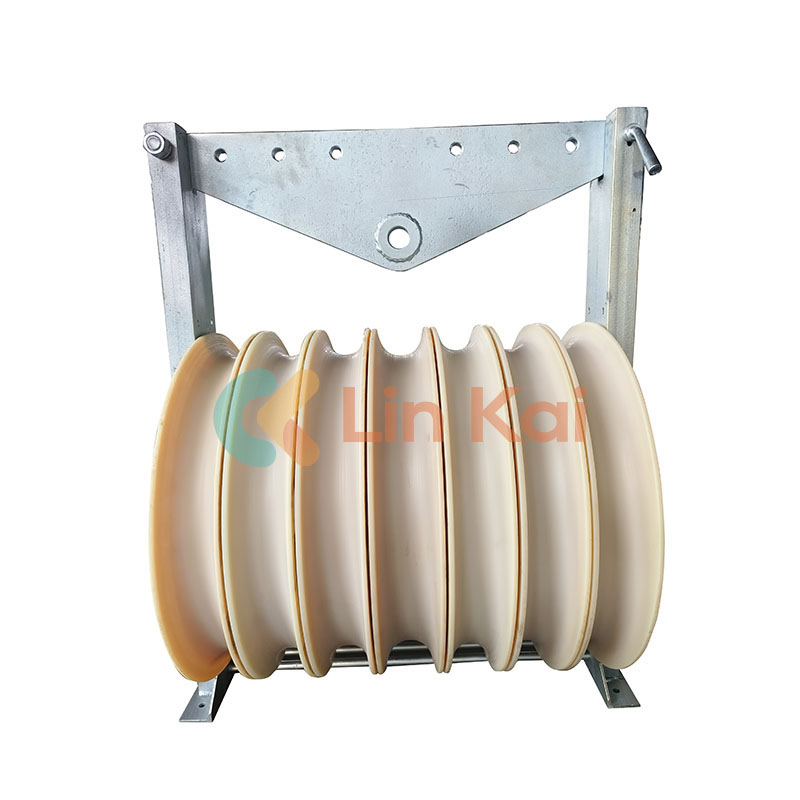Power and Precision: Handling Heavy Loads with Large Diameter Stringing Blocks
2024-05-15
In the power line industry, the installation and maintenance of overhead power lines often involve dealing with heavy loads. This is especially true for modern power lines that use larger conductors to meet increasing energy demands. Large Diameter Stringing Blocks are essential tools in this process, designed to handle these heavy loads efficiently and safely. But how exactly do these blocks manage to bear such substantial weights? Let’s explore the engineering and design features that enable Large Diameter Stringing Blocks to handle heavy loads.
The Role of Large Diameter Stringing Blocks
Large Diameter Stringing Blocks are used to guide and support conductors (wires or cables) during the stringing process. Their primary function is to reduce friction and provide a smooth pathway for the conductors, ensuring efficient and damage-free installation. Handling heavy loads is a critical aspect of their functionality, and several key design features contribute to this capability.
Key Design Features for Handling Heavy Loads
1. Robust Construction Materials
The choice of materials is fundamental to the load-bearing capacity of stringing blocks.
- High-Strength Metals: Materials like galvanized steel and high-grade aluminum alloys are commonly used. These metals offer exceptional strength-to-weight ratios, allowing the blocks to support heavy loads without excessive bulk.
- Durability: These materials are also chosen for their durability and resistance to wear, ensuring the blocks can withstand the rigors of heavy-duty use over time.
2. Large Diameter Sheaves
The large diameter of the sheaves (the rotating part of the block) is crucial for several reasons.
- Load Distribution: A larger diameter provides a greater surface area for the conductor to rest on, distributing the load more evenly. This reduces pressure points and minimizes the risk of damage to the conductor.
- Reduced Bending Stress: The larger diameter also means the conductor experiences less bending stress as it passes over the block, which is especially important for maintaining the integrity of heavier, less flexible conductors.
3. High-Quality Bearings
Bearings are essential for smooth operation and are designed to handle high loads.
- Load-Bearing Capacity: The bearings used in large diameter stringing blocks are designed to support significant weights. They are typically made from high-strength materials and engineered to distribute loads evenly.
- Smooth Rotation: High-quality bearings ensure that the sheave rotates smoothly under load, reducing friction and wear on both the block and the conductor.
4. Reinforced Frames and Housings
The frame or housing of the stringing block must be robust enough to handle the overall load.
- Reinforcement: Frames are often reinforced with additional supports or made from thicker, more durable materials to handle the stresses of heavy loads.
- Design for Stability: The design of the frame also includes features to enhance stability and prevent deformation under load, ensuring the block remains secure and functional during use.
5. Safety Features
Handling heavy loads also requires robust safety features to prevent accidents and equipment failure.
- Secure Latches and Locks: These features ensure that the conductor remains securely in place within the block, even under high tension.
- Load Indicators: Some advanced blocks include load indicators that help operators monitor the stress being applied to the block, ensuring it remains within safe operating limits.
6. Versatile Mounting Options
Properly securing the stringing block is essential for safely handling heavy loads.
- Multiple Mounting Points: Stringing blocks often feature multiple mounting points or adjustable mounts to ensure they can be securely attached to different structures, such as poles or towers.
- Robust Mounting Hardware: The mounting hardware itself is made from high-strength materials to ensure it can support the full load without failure.
Practical Applications and Benefits
The design features that enable Large Diameter Stringing Blocks to handle heavy loads provide several practical benefits in the field:
- Efficiency: By handling heavy loads effectively, these blocks allow for quicker and more efficient stringing operations, reducing overall project time.
- Safety: Robust safety features and load-bearing capabilities ensure that operations can be carried out safely, protecting both workers and equipment.
- Durability: High-quality materials and construction methods ensure that the blocks can be used repeatedly in demanding conditions without significant wear or risk of failure.
Conclusion
Large Diameter Stringing Blocks are engineered to handle the substantial loads associated with modern power line installations. Through the use of high-strength materials, large diameter sheaves, high-quality bearings, reinforced frames, and robust safety features, these blocks ensure that heavy conductors can be installed efficiently, safely, and without damage. Understanding these design features helps industry professionals select the right tools for their projects, ensuring successful and reliable power line installations. As the demands on power infrastructure continue to grow, the importance of such durable and capable tools will only increase, cementing their role as indispensable assets in the power line industry.


